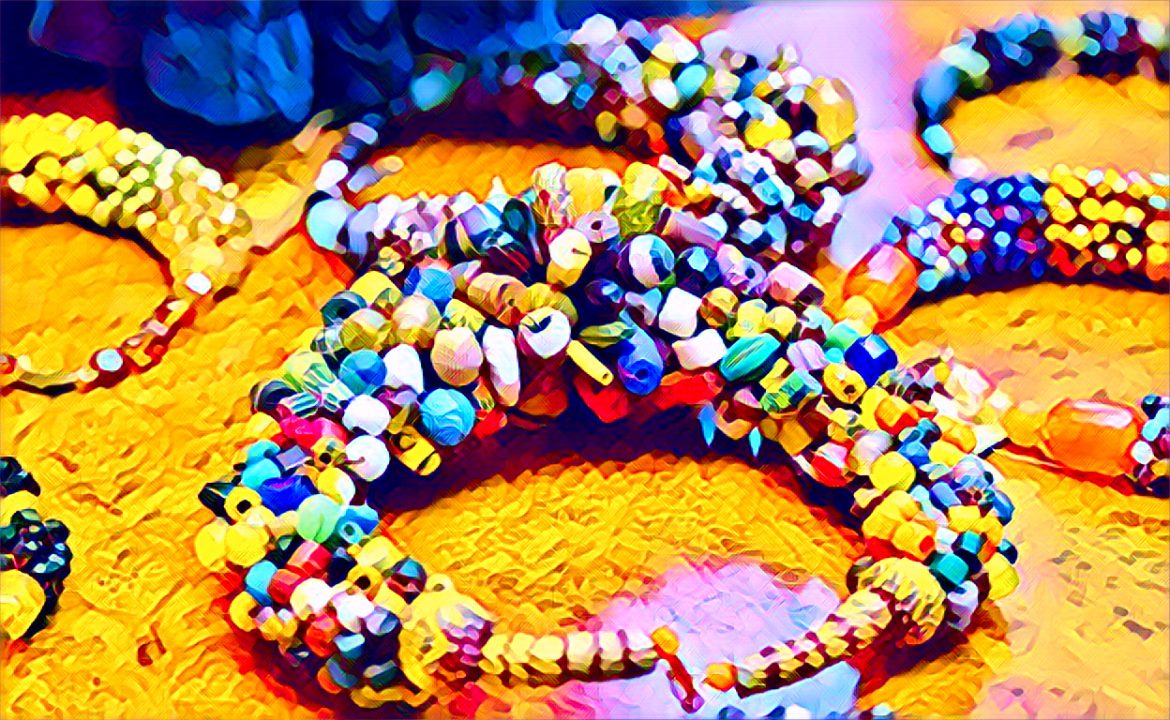KEY POINTS
- Beads in Ghana hold deep spiritual and cultural meanings, often used in significant life events like marriages and funerals.
- Different bead colors and designs communicate messages about the wearer’s status, wealth, and identity.
- The bead-making industry in Ghana provides economic opportunities, especially through the use of sustainable materials.
In Ghana, beadwork is deeply ingrained and symbolizes much more than just a craft. It is an essential way to convey spirituality, history, and identity.
For generations, Ghana’s rich cultural legacy has been embodied via the centuries-old craft of beadmaking, which is also vital to many rituals and events. The main facets of Ghanaian beadwork and its influence on cultural identity are examined here.
Historical and spiritual significance
In Ghana, beads have been made for millennia by early craftspeople who used natural materials including glass, clay, and bone. These beads served as both social prestige and spiritual protection, making them more than just ornaments.
As they were thought to have protective qualities, beads were frequently worn as charms or amulets to ward off bad spirits. Beads have historically been used to commemorate important life events including marriages, deaths, and births.
Cultural expression and communication
In Ghana, beads are used as a language of communication, with various hues, sizes, and designs expressing distinct ideas. For instance, white beads stand for purity, green beads for fertility, and gold beads for riches.
During traditional events like the Dipo rite, where girls undergoing a transition into womanhood wear certain beads that represent their maturity and marital preparedness, this symbolic language is clearly visible.
Economic and social role
For many Ghanaian craftspeople, beadwork is also a major source of income, particularly in areas like Kroboland, which is renowned for its elaborate glass beads.
These craftspeople emphasize the sustainability of the craft by using traditional techniques to make beads out of recycled materials. In addition to maintaining traditional customs, the bead industry boosts regional economy through international fashion marketplaces and tourism.
Role in ceremonial life
From naming rites to funerals, beads play a significant role in Ghana‘s most significant life celebrations. For instance, certain beads are worn during funerals to honor and grieve the deceased. However, beads are worn at weddings to symbolize unity and prosperity.
The significance of beads as symbols of rank, identity, and intergenerational continuity is highlighted by their use in various occasions.
Modern adaptation and global appeal
Ghanaian beadwork has a long history, but it is still evolving today. These days, traditional beads are being used by young designers and craftspeople to create contemporary jewelry and clothing that appeals to both domestic and foreign consumers.
By using repurposed materials, this renaissance promotes ecological practices while still preserving the skill. Beyond Ghana’s boundaries, African beadwork’s enduring appeal and cultural relevance are highlighted by the growing interest in it around the world.
Ghanaian beadwork is more than just an art form; it is a live representation of the country’s history, religion, and culture that is constantly being modified to satisfy contemporary demands while respecting long-standing customs.





9 comments
Amazing blog! Do you have any suggestions for aspiring writers? I’m planning to start my own site soon but I’m a little lost on everything. Would you recommend starting with a free platform like Wordpress or go for a paid option? There are so many choices out there that I’m totally confused .. Any tips? Cheers!
A person essentially help to make seriously posts I would state. This is the first time I frequented your website page and thus far? I surprised with the research you made to make this particular publish amazing. Fantastic job!
I love what you guys are up too. This type of clever work and exposure! Keep up the awesome works guys I’ve you guys to my blogroll.
I like this blog very much, Its a really nice place to read and obtain information. “I look upon every day to be lost, in which I do not make a new acquaintance.” by Samuel Johnson.
hello!,I love your writing so a lot! proportion we keep in touch more approximately your article on AOL? I need a specialist on this house to resolve my problem. Maybe that is you! Looking ahead to peer you.
Hey there just wanted to give you a quick heads up. The words in your article seem to be running off the screen in Ie. I’m not sure if this is a formatting issue or something to do with web browser compatibility but I thought I’d post to let you know. The design look great though! Hope you get the issue resolved soon. Kudos
It’s a pity you don’t have a donate button! I’d certainly donate to this excellent blog! I suppose for now i’ll settle for book-marking and adding your RSS feed to my Google account. I look forward to new updates and will share this blog with my Facebook group. Chat soon!
This website is my breathing in, real wonderful style and design and perfect subject material.
I have been examinating out some of your stories and it’s pretty clever stuff. I will definitely bookmark your site.